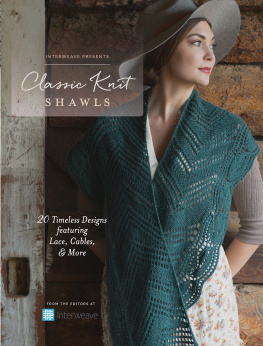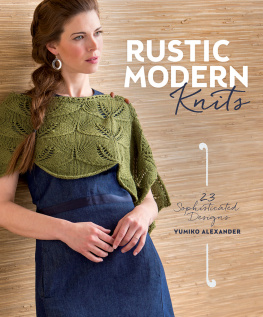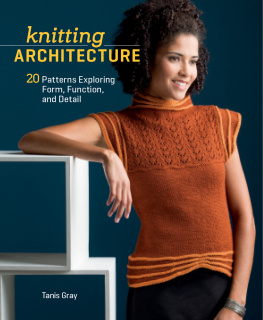Free-Spirit
Shawls
20 Eclectic Knits
for Every Day
Lisa Shroyer


Contents
, Hilary Smith Callis
, Melissa J. Goodale
, Melissa J. Goodale
, Maura Kirk
, Rosemary (Romi) Hill
, Alexis Winslow
, Alexandra Beck
, Kyoko Nakayoshi
, Angela Tong
, Angela Tong
, Mercedes Tarasovich-Clark
, Heather Zoppetti
, Amy Gunderson
, Alexandra Beck
, Tabetha Hedrick
, AnneLena Mattison
, Angela Tong
, Mercedes Tarasovich-Clark
, Mercedes Tarasovich-Clark
, Carol Feller
, Kyoko Nakayoshi
, Kate Gagnon Osborn
, Lisa Shroyer

The knitted shawl has become an icon in our strange little crafty world. What is it about this brief accessory, this slip of lace on the shoulders, this ever-morphing shape, that so enchants us?
As editor of Knitscene, I have seen my share of shawl designs. Shawl projects are a staple in the magazine, both because designers are always submitting interesting interpretations of them and because our readers love them so much. From this popularity came the idea to do a shawl book devoted to the triangles, semicircles, and rectangles that provide space for fun stitches, color play, and cool finishing treatments. I hope you enjoy the projects and tutorials in the book. May they take you to new heights of knitting expression!
Lisa Shroyer

This book is about knitting contemporary shawls and shawlettesand incorporating fun techniques, quirky elements, and unusual yarns into your designs. The photography reflects my thinking about the shawlas an accessory, its feminine, bold, stylish, and versatile.
This is not a book about ethnic shawl traditions or heritage techniques. Many wonderful sources for this information are available, and I encourage you to do that research; it will enrich your knitting life. See for some recommendations.
Youll see that the shawls in this collection are organized by four themes: Color, Lace, Simplicity, and Texture.
- Color introduces stripes, slipped stitches, zigzags, and color-blockingall manipulations of multiple colors in one project.
- Lace explores the endless possibilities rendered by the simple yet dramatic yarnover.
- Simplicity uses variegated yarns and simple stitches to create striking shawls that most knitters will find accessible.
- Finally, Texture takes on cables, knit-purl combinations, and the nubbly surfaces garter stitch can create.
Lets talk about style. Many knitters enjoy knitting shawls but arent quite sure how best to show them off. There are so many possible ways to wear your shawl, and it can be fun to experiment.
For smaller shawls: a shawl about 26" (66 cm) wide across the top edge makes a great kerchief. Simply hang the point in front and wrap the ends around the neck, knotting them in placeor bring the ends forward after wrapping them around the neck. Small and medium-sized shawls can also be wrapped around the shoulders off-center, so that the opening hits near the front of the shoulder. Knot the ends there or pin with a brooch.

Side wrap. Pictured: Euclid ().
For delicate lace or larger-sized shawls: Think about ensemble. A large traditional looking shawl doesnt have to look frumpy if you pair it with fresh styles and remember that its an accessory. Use these shawls as part of your lookgo Boho with torn denim, big jewelry, and flowy fabrics, or go dress-up with a slinky dress and dramatic earrings. A lace shawl can always be bundled and looped around the neck like a scarf. Though you wont see all the detail, the effect can still be striking.

Front knotted. Pictured: Mineral ().

Kerchief, draped in front. Pictured: Basilica ().
Of course, almost all shawls can be worn traditionally, with the deepest part of the center straight down the back and the ends draped in front. You can wear sweet little semicircles and crescents this way and look very stylish today. Top a strapless dress with one and you have instant romance.
Some shawl designs lend themselves to a tougher, more urban aesthetic. The projects in the Color chapter (see ), can be worn like scarves, slung around the neck, or wrapped and tied.

Side knotted. Pictured: Lindsay ().

Traditional, draped over shoulders. Pictured: Glen Lennox ().

Superwash sock yarn also makes a great choice for a shawlette. Choose one phenomenal skein of yarnperhaps hand-dyedand get a full project out of it. Many popular designs both online and in this book are worked in fingering-weight yarn, which makes sock yarn an ideal substitute.

Like scarves, shawls can be worn for warmth as much as for style. If you need a warm accessory, yarn choice is important. The projects in the Texture chapter (see ) are worked in heavier yarns with a lot of animal-fiber content. Bundle up in a long, cabled wrap and let the wind blowyoull be cozy and comfortable. Shawls can be transeasonal as wella silk laceweight yarn or superwash sock yarn can make spring and summer-ready wraps. Designs in the Lace chapter are well-suited to warm weather, but dont underestimate the potential warmth of a wool-silk blend in a fingering weight.
Each pattern in this book lists the actual yarn used, as well as the Craft Yarn Council of Americas weight categorizations (yarnstandards.com). But because shawls dont need to fit or be any certain size, and gauge is in the eye of the beholder, you can switch any of the yarns to another weight. The size and drape of the piece will change, but that could create some cool effects. Always swatch with your proposed yarn and needles and compare your gauge to the patterns. If you get fewer stitches/rows per inch than the pattern, your finished shawl will be larger than the sample. If you get more, your shawl will be smaller than the sample.
















